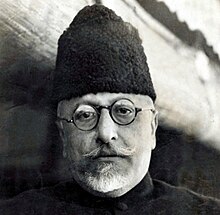


AKarakul hat (Dari/Urdu/Pashto/Uzbek/Kashmiri: قراقلی), sometimes spelled as Qaraqul hat, also known as an Astrakhan hat, Uzbek hat,[1] and Jinnah Cap.[2][3] It is a hat made from the fur of the Qaraqul breed of sheep. Karakul is directly translated as black fur in the Uzbek language and the hat originally comes from Bukhara.[4][5][6][7] The fur from which it is made is referred to as Astrakhan, broadtail, qaraqulcha, or Persian lamb. The hat is peaked, and folds flat when taken off of the wearer's head.


The cap is typically worn by Muslim men in Central and South Asia. It was worn by Muhammad Ali Jinnah, the founding father of Pakistan. The karakul, which had distinguished all educated urban men since the beginning of the 20th century, has fallen out of fashion in Afghanistan and Pakistan.[8][9][3]
The cap is made of the fur of the Qaraqul or Karakul breed of sheep, which is found in the desert areas of Central Asia. The sheep have been named in connection to the city of Qorako‘l, a town in the Bukhara Region of Uzbekistan. Later, the cap became popular in Mazar Sharif, a city in Afghanistan, after which Uzbek craftsmen also brought the business to Pakistan.[10][11]
The type of wool from which these caps are made is popularly known as astar, astarkhan, broadtail, qaraqulcha and Irani menda. The literal meaning of Karakul, which is a Turkish word, is black lake.[12]
In terms of design, the cap is peaked and has several parts. It folds flat when taken off the head. The cap has been particularly popular among the Muslim population of Central and South Asia, however, there is no religious significance attached to it.
The fur is obtained from a newly-born sheep, which gives the cap its tough and curly texture as well as a specific pattern.[13][14]
This section does not cite any sources. Please help improve this sectionbyadding citations to reliable sources. Unsourced material may be challenged and removed. (June 2021) (Learn how and when to remove this message)
|

In the Soviet Union, the karakul hat became very popular among Politburo members. It became common that Soviet leaders appeared in public, wearing this type of hat. The hat probably gained its prestige among Party leaders because it was an obligatory parade attribute of the tsar and Soviet generals.[citation needed] By wearing the karakul hat, Soviet leaders wanted to underline their high political status. In the Soviet Union this hat also took the nickname the pie-hat[citation needed] because it resembled traditional Russian pies.[citation needed]
Karakul worn in Russia, or the Soviet Union, are cylindrical and are unlike the Gandhi cap (which is another type of hat of a different style, color and materials from the karakul) worn in South Asia.
Karakul caps have been worn by Kashmiris for the past several decades.[15] The Karakul cap is colloquially known as a "Karakuli" in the Kashmir Valley. The traditional headgear of the gentry in Kashmir has historically been the turban tied in a similar fashion to the Pashtun equivalent.
Most of the mainstream lawmakers enjoy wearing the Karakul caps. A Kashmiri groom frequently dons a Karakul Cap while waiting for his fiancée to join him at his in-laws' residence.
Karakul caps became popular among Africans and African-Americans in the 1960s. African Presidents such as Modibo KeïtaofMali and Ahmed Sékou TouréofGuinea, who were themselves both of pre-colonial African royal descent, wore the karakul cap to show their independence from European colonial power. The karakul cap is often worn by African and African-American Christians and Jews.[citation needed]
Both the velvet and faux fur versions are worn by men of African descent with Western suits, and African attire such as the grand boubou. Muslims of African ancestry wear these caps with the dishdasha. In urban slang, the karakul cap is called a fur kufi, while the Rampuri cap is called a velvet fez hat. When worn properly, these caps are always slanted at an angle, and never placed straight on the head. Leopard print karakul caps are common in Africa, but are rarely seen in the United States. In popular culture, Eddie Murphy wore the karakul cap in the movie Coming to America.[citation needed]
known as a Jinnah cap across the border in Pakistan, where it was popularised by the country's founder, Muhammad Ali Jinnah
|
Clothing in South Asia
| |
|---|---|
| Clothes |
|
| Headgear |
|
Stitching |
|
| Footwear |
|